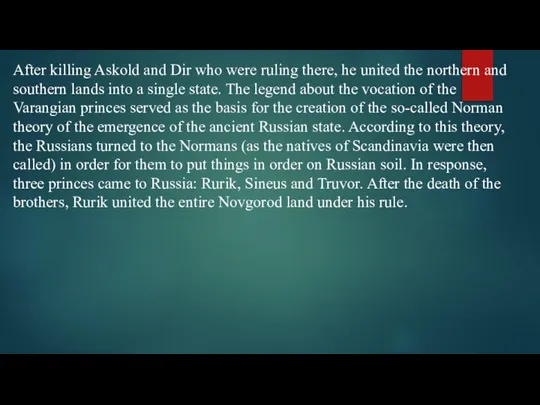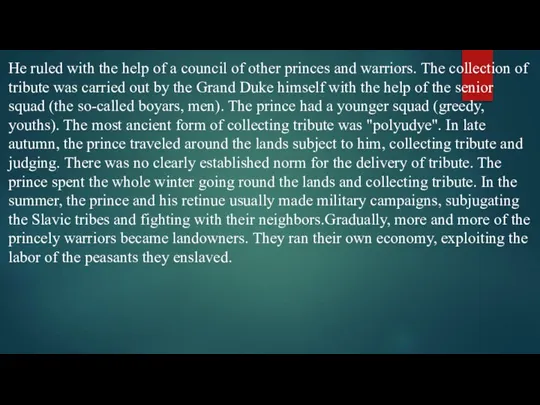Содержание
- 2. On the territory occupied by Slavic tribes, two Russian state centers were formed: Kiev and Novgorod,
- 3. After killing Askold and Dir who were ruling there, he united the northern and southern lands
- 4. He ruled with the help of a council of other princes and warriors. The collection of
- 6. Скачать презентацию
Слайд 2On the territory occupied by Slavic tribes, two Russian state centers were
On the territory occupied by Slavic tribes, two Russian state centers were

formed: Kiev and Novgorod, each of which controlled a certain part of the trade route "from the Varangians to the Greeks." In 862, according to The Tale of Bygone Years, the Novgorodians, wishing to end the internecine struggle that had begun, invited the Varangian princes to rule Novgorod. The Varangian prince Rurik, who arrived at the request of the Novgorodians, became the founder of the Russian princely dynasty. The date of the formation of the ancient Russian state is conventionally considered 882, when Prince Oleg, who seized power in Novgorod after Rurik's death, undertook a campaign against Kiev
Слайд 3After killing Askold and Dir who were ruling there, he united the
After killing Askold and Dir who were ruling there, he united the

northern and southern lands into a single state. The legend about the vocation of the Varangian princes served as the basis for the creation of the so-called Norman theory of the emergence of the ancient Russian state. According to this theory, the Russians turned to the Normans (as the natives of Scandinavia were then called) in order for them to put things in order on Russian soil. In response, three princes came to Russia: Rurik, Sineus and Truvor. After the death of the brothers, Rurik united the entire Novgorod land under his rule.
Слайд 4He ruled with the help of a council of other princes and
He ruled with the help of a council of other princes and

warriors. The collection of tribute was carried out by the Grand Duke himself with the help of the senior squad (the so-called boyars, men). The prince had a younger squad (greedy, youths). The most ancient form of collecting tribute was "polyudye". In late autumn, the prince traveled around the lands subject to him, collecting tribute and judging. There was no clearly established norm for the delivery of tribute. The prince spent the whole winter going round the lands and collecting tribute. In the summer, the prince and his retinue usually made military campaigns, subjugating the Slavic tribes and fighting with their neighbors.Gradually, more and more of the princely warriors became landowners. They ran their own economy, exploiting the labor of the peasants they enslaved.
- Предыдущая
Настольные игры c макросом Повседневная жизнь и быт при Петре I
Повседневная жизнь и быт при Петре I Александр I (1801-1825). Внешняя политика. 8 класс
Александр I (1801-1825). Внешняя политика. 8 класс Россия при Василии III
Россия при Василии III Ұлы Отан Соғысы
Ұлы Отан Соғысы Презентация на тему Культура Междуречья
Презентация на тему Культура Междуречья  Архитектура Древней Руси 11-14 вв
Архитектура Древней Руси 11-14 вв Деловое наследие купцов Савельевых
Деловое наследие купцов Савельевых Присоединение Сибири к России
Присоединение Сибири к России Оленегорск. Мурманская область
Оленегорск. Мурманская область Битва на Курской дуге
Битва на Курской дуге Город на Двине. Архангельск
Город на Двине. Архангельск Материалы для подготовки к викторине. Важнейшие изобретения 2-го тысячелетия н.э
Материалы для подготовки к викторине. Важнейшие изобретения 2-го тысячелетия н.э Древняя Спарта. Спартанское воспитание
Древняя Спарта. Спартанское воспитание Презентация на тему "Иван Грозный - первый русский царь" - презентации по Истории
Презентация на тему "Иван Грозный - первый русский царь" - презентации по Истории  Хрустицкий Владислав Владиславович. Герой Советского Союза. Их именами названы
Хрустицкий Владислав Владиславович. Герой Советского Союза. Их именами названы Лекция 14. Период застоя. СССР в сер. 60–х – нач. 8–х гг
Лекция 14. Период застоя. СССР в сер. 60–х – нач. 8–х гг История бренда Faber-Castell
История бренда Faber-Castell Герои–защитники
Герои–защитники Памятник-часовня героям Отечественной войны 1812 года в Полоцке
Памятник-часовня героям Отечественной войны 1812 года в Полоцке Декоративное освещение исторических зданий на Урале
Декоративное освещение исторических зданий на Урале Историко-правовой опыт деятельности полиции дореволюционной России по предупреждению распространения проституции
Историко-правовой опыт деятельности полиции дореволюционной России по предупреждению распространения проституции Великие женщины России
Великие женщины России Семь чудес света
Семь чудес света Два Александра. Как Царь помог Поэту
Два Александра. Как Царь помог Поэту Священная война
Священная война Презентация на тему Первобытные орудия труда (5 класс)
Презентация на тему Первобытные орудия труда (5 класс)  Посещение Екатериной II столицы Тавриды. Великая императрица в г. Симферополе. Авторская экскурсия по г. Симферополю
Посещение Екатериной II столицы Тавриды. Великая императрица в г. Симферополе. Авторская экскурсия по г. Симферополю Великая Отечественная война
Великая Отечественная война